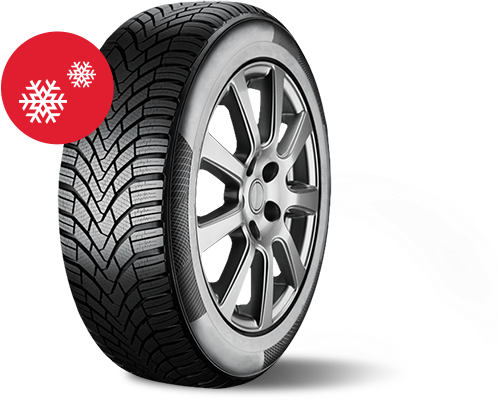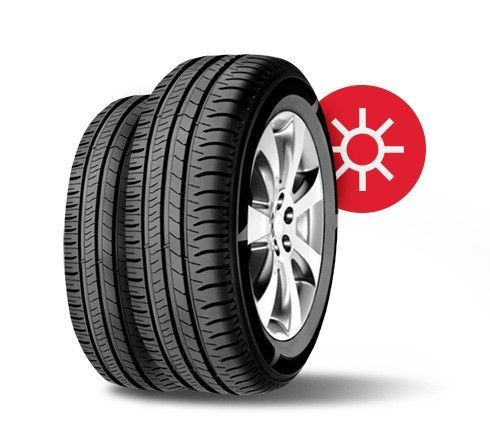Winter can often prove a tough time for motorists
With conditions set on making it difficult to get anywhere. Fortunately, there are ways to prepare your car, one of which being winter tyres. Winter tyres are definitely something to consider during the cold winter months, but are they worth it?. Take a look at the benefits of winter tyres and book your car in for a fitting.

Is the Switch to Winter Tyres Worth It?
With busy lives, many of us rely heavily on our cars to get us from A to B. So, as the weather gets colder, it’s time to keep mobile by considering the use of winter tyres. Despite the fact that winter tyres can reduce stopping distances on ice and snow by up to half - yes, we said half! - their use is still relatively uncommon in the UK.
Let’s look at what makes fitting winter tyres worth it.
In many areas of Europe, such as Finland and Sweden, it’s actually a legal requirement that you fit winter tyres on your vehicle for the duration of the coldest season. In others, such as Germany and Spain, suitable tyres or chains must be fitted whenever road signs instruct. In the UK, however, we have no such laws, leaving many people to ask 'Are winter tyres worth
What’s Special About Winter Tyres?
The main difference between winter tyres and normal ones is simply tread depth. On standard tyres, it starts at between seven and eight millimetres, whereas winter tyres increase that to between eight and nine. The grooves within the tyre are both wider and deeper as well. While all-season tyres can perform reasonably well in most weather conditions, they don't do well in extremes - hot or cold. As such, most drivers in the UK should use both summer and winter tyres, each at the appropriate time of year.
It’s not just a money making ploy by the tyre manufacturers!
Remember, swapping your tyres can mean that each set will last longer. The real benefit comes from ensuring better safety for you and your passengers when the temperature drops, and ice and snow become less of a winter wonderland and more of a driving challenge.
A test, carried out by Tyresafe, looked at the stopping distances of cars fitted with summer and winter tyres, while travelling at 62 mph at 5˚C. Scarily, the car wearing summer tyres took almost 5m further to come to a halt than the winter tyre-clad car. Throw in some ice and snow, and a car using summer tyres can take twice as far to stop.
It’s clear which we’d rather have if we needed to make a sudden stop.
So, are winter tyres worth it? Definitely! Structurally speaking, summer tyres will stiffen up as soon as the temperature starts to get lower. This significantly hurts performance. Winter tyres, on the other hand, rely on a rubber that has a high amount of silica, allowing them to remain soft. You want your tyres to stay soft enough so that they can provide grip; they must be able to adjust to the road.
The tread pattern of winter tyres is also different, allowing them to remain flexible even in lower temperatures. Take a closer look at winter tyres and you will notice fine grooves in every tread block, which are better at biting into the snow. The result is that winter tyres have improved handling and braking performance on ice or snow. In wet and icy conditions, winter tyres are able to provide better grip and stop quicker. This, in turn, aids road safety and gives drivers that additional peace of mind when driving in rough weather. Marked by either a snow-topped mountain or snowflake, it’s easy to spot a winter tyre and they should cost pretty much the same as a summer tyre.


When Is Switching to Winter Tyres Worth It?
It’s not rocket science - summer tyres are necessary for traction and stability when driving in warm months, while winter tyres become necessary in cold months. But what is the real definition of ‘cold driving conditions’?
When the temperature is above 7˚C, summer tyres are the best way to ensure high grip on both dry and wet roads. This is a result of their tread compounds and patterns. They also have optimum efficiency and driving stability in summer temperatures.
Winter tyres, on the other hand, grip much better in temperatures below 7˚C. They specifically maximize control in slippery and wet conditions. Winter tyres can also improve cornering performance, allowing you to turn in a situation where you would have kept skidding straight ahead if you had summer tyres. All this definitely makes the switch to winter tyres worth it when the temperature drops.
Since it is not practical to change between summer and winter tyres every time the weather changes, a simple rule of thumb is to use summer tyres from April to October (when, according to the Met Office, minimum temperatures fall below that magic 7˚C in the Northwest and many other parts of the UK) and winter tyres the rest of the year.
Are Winter Tyres for Me?
The AA suggests that you invest in winter tyres if the area you live in regularly experiences cold weather, or snow and ice.
Winter tyres are a necessity for those living in remote parts of the country, as roads can be left out of winter road salting routines and the conditions tend to remain worse for a longer period. Indeed, for many living in rural areas, road travel is necessary to reach essential facilities.
Those who live in cities and areas of the country with less severe weather and easier access to amenities will have to decide whether winter tyres are necessary for them. You might find winter tyres worth it if you consider how likely you are to experience poor weather and think about how you could survive a cold spell without the use of your car.
The RAC reminds you to always check the regulations before taking your car to other areas of Europe, as many other countries require winter tyres by law. If hiring a car abroad, you should also check whether it has been kitted out with the required tyres, even if they are compulsory in that neck of the woods.
Are Two Sets of Tyres Really Practical?
Now that we’ve seen evidence of the improved traction, handling and stopping distances that make the switch to winter tyres worth it, you might be tempted to simply leave winter tyres on year-round. Don’t! The softer compound used in winter tyres is not helpful in the summer. In fact, using winter tyres in the summer is as bad as using summer tyres in the winter. You’ll have longer stopping distances, a higher risk of skidding, and greater wear and tear.
Worried about additional costs and storage issues, many car owners dislike the idea of buying a set of winter tyres in addition to their summer tyres. However, owning two full sets of tyres means that the wear is spread over eight tyres rather than four. Each set is only used half of the year, in theory delaying the replacement of your summer tyres.
